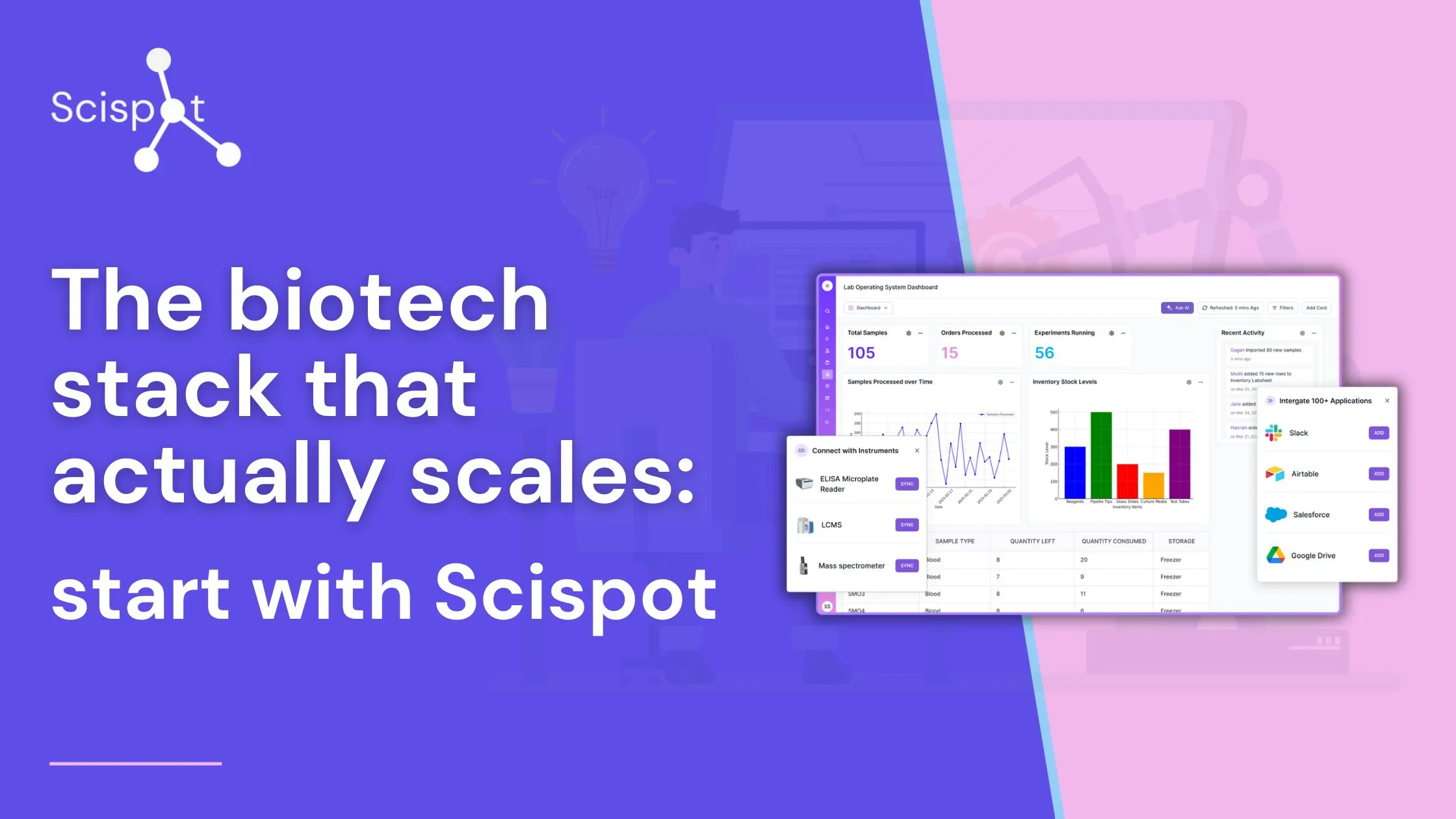For biotherapeutics companies scaling from R&D into full-scale manufacturing, one crucial question often arises: How do we choose the right lab software for this transition?
The right software is critical for ensuring efficient, compliant, and scalable operations. Making the wrong choice can lead to inefficiencies, bottlenecks, or even regulatory risks. In this guide, we’ll explore the key factors companies must consider when selecting lab software to bridge the gap between R&D and manufacturing—and how Scispot provides the ideal solution for this critical phase.
Understanding the Transition: Why It Matters for Biotherapeutics Companies
As biotherapeutics companies move from R&D into manufacturing, they face a significant shift in operational priorities. The flexibility and experimentation of R&D must give way to the standardization, compliance, and scalability required for large-scale production. What worked in the lab often lacks the structure needed for regulated manufacturing processes.
Scispot was designed to meet these evolving needs. Whether it’s ensuring data accuracy, compliance, or seamless scalability, Scispot’s platform serves as a unified hub that allows companies to transition smoothly from discovery to production, connecting R&D with manufacturing in a seamless, integrated workflow.
1. Integrated R&D to Manufacturing Workflow: Bridging the Gap
Many biotherapeutics companies operate as "integrated development and manufacturing organizations" (IDMO), meaning they aim to seamlessly connect their R&D processes with manufacturing. The challenge becomes: How do we select lab software that can integrate these two critical functions without creating silos?
Scispot excels at bridging this gap by enabling an integrated workflow from early-stage R&D all the way through to large-scale manufacturing. Data and workflows can flow effortlessly between departments, ensuring smooth coordination across the company.
Why Integrated Workflows Matter:
When companies can seamlessly move data from R&D into manufacturing, they not only save time but also ensure consistency across experiments and production runs. Scispot’s platform enables biotherapeutics companies to link their lab and production teams, facilitating a unified development process.
"The shift from small-scale R&D to large-scale manufacturing brought continuous challenges. We required a fully digitized, data-driven platform like Scispot to seamlessly integrate lab operations, automate workflows, and convert raw data into actionable insights. Scispot effectively bridged the gap between R&D and commercial production." — CSO, Clinical Biotech Scaleup
Impact:
- Elimination of data silos between R&D and manufacturing.
- Streamlined communication and handoffs between teams.
- Improved efficiency, reducing time-to-market for therapies.
2. Scalable and Standardized Processes: Flexibility Meets GMP
As biotherapeutics companies scale, they must find software that supports both flexible R&D experimentation and the structured standardization required for GMP (Good Manufacturing Practice) manufacturing. This leads many to ask: How can lab software handle process optimization in R&D while supporting the standardization needed in manufacturing?
Scispot provides the perfect balance between flexibility and standardization. The software allows companies to iterate and optimize their processes in the R&D phase while also enabling the standardization necessary for GMP compliance. This ensures that companies can grow without sacrificing process consistency.
Why Standardization Matters:
In the manufacturing phase, reproducibility and compliance with regulatory requirements are critical. Scispot allows biotherapeutics companies to lock down their workflows with structured SOPs (Standard Operating Procedures) while maintaining the flexibility to innovate during early development.
Impact:
- Flexibility during R&D that transitions into structured, repeatable processes in manufacturing.
- Faster process validation and smoother regulatory approvals.
- Consistency in product quality across all stages.
3. Regulatory Compliance: Built-in Support for GMP, GLP, and HIPAA
Compliance with strict regulations like GMP, GLP, and HIPAA is mandatory for biotherapeutics companies, especially as they move into manufacturing. Companies often ask: Which lab software can ensure we stay compliant while also meeting the needs of large-scale production?
Scispot was built with compliance in mind, featuring built-in audit trails, reporting tools, and data integrity checks that ensure companies meet all regulatory requirements. Whether a company is producing cell therapies or exosome therapeutics, Scispot enables full regulatory compliance with minimal effort.
Why Regulatory Compliance Matters:
Maintaining compliance with industry standards is critical for avoiding costly fines, delays, and operational shutdowns. Scispot’s compliance features provide automatic audit logs, real-time monitoring, and customizable reports to keep companies audit-ready.
Impact:
- Faster, more efficient regulatory approvals.
- Confidence in audit readiness and data integrity.
- Reduced risk of non-compliance penalties or operational disruptions.

4. Data-Driven Decision Making: Turning Information into Insights
As companies grow, the ability to collect, integrate, and extract valuable knowledge from their data becomes essential. This leads companies to ask: How can our lab software enable data-driven decisions that improve both R&D and manufacturing outcomes?
Scispot empowers biotherapeutics companies to turn raw data into actionable insights. With its powerful analytics and data integration tools, Scispot helps companies use historical data to inform decisions, optimize processes, and improve product quality. This enables data-driven decision-making across both R&D and manufacturing.
Why Data-Driven Decisions Matter:
Companies that leverage data effectively are able to optimize their processes, reduce rework, and identify trends before issues arise. Scispot’s data integration capabilities ensure that companies can extract actionable insights from their data, driving continuous improvement in both R&D and manufacturing.
Impact:
- Reduced need to repeat experiments due to poor data quality.
- Faster decision-making based on accurate, historical data.
- Enhanced process optimization through predictive insights.
5. Operational Efficiency: Automating Workflows and Reducing Manual Tasks
Operational efficiency is key as companies move into manufacturing. They often wonder: How do we choose lab software that can automate inventory management, experiment setup, and other manual tasks to save time and resources?
Scispot helps biotherapeutics companies automate a wide range of lab processes, from managing inventory to streamlining workflows. By reducing the manual burden on lab teams, Scispot improves operational efficiency and frees up time for more high-value work.
Why Operational Efficiency Matters:
As companies scale, inefficiencies in their processes can lead to delays and bottlenecks. Scispot’s automation features, such as real-time inventory tracking and automated experiment setup, reduce these inefficiencies, allowing teams to focus on research and production without being bogged down by administrative tasks.
Impact:
- Improved throughput by automating repetitive processes.
- Reduced time spent on manual tasks, improving overall productivity.
- Increased focus on high-value tasks like research and development.
Why Scispot is the Ideal Solution for Biotherapeutics Companies
As biotherapeutics companies transition from R&D to manufacturing, choosing the right lab software is critical. Scispot provides an all-in-one solution that meets the needs of this transition, offering a platform that integrates workflows, supports scalability, ensures compliance, and enables data-driven decision-making.
With Scispot, biotherapeutics companies can:
- Seamlessly connect R&D and manufacturing operations for smoother scaling.
- Standardize processes while maintaining flexibility during early-stage development.
- Meet strict regulatory requirements with built-in compliance features.
- Leverage data to improve decision-making and optimize workflows.
- Automate lab processes to improve operational efficiency and reduce manual tasks.
Setting Your Biotech Up for Success
Transitioning from R&D to manufacturing is a critical inflection point for biotherapeutics companies. Choosing the right lab software that can handle increased complexity, regulatory requirements, and scalability needs is essential for long-term success. Scispot is designed to meet these challenges head-on, providing a unified platform that supports this transition while ensuring operational efficiency and compliance.
By choosing Scispot, you’re not just selecting lab software—you’re building the digital infrastructure that will support your company's growth, efficiency, and compliance, allowing you to deliver innovative therapies to market faster and more effectively.





.jpg)






